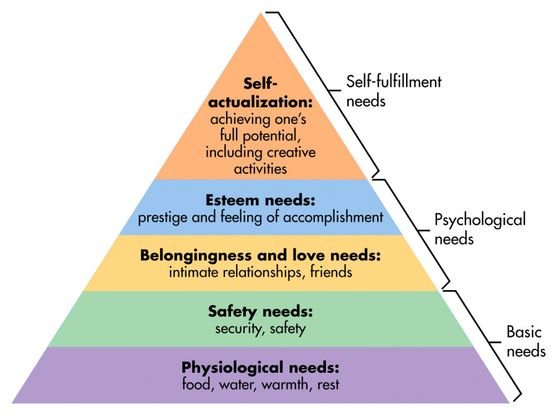By Dr. Saul McLeod
From the bottom of the hierarchy upwards, the needs are: physiological (food and clothing), safety (job security), love and belonging needs (friendship), esteem, and self-actualization.
Needs lower down in the hierarchy must be satisfied before individuals can attend to needs higher up.

Deficiency needs vs. growth needs
This five-stage model can be divided into deficiency needs and growth needs. The first four levels are often referred to as deficiency needs (D-needs), and the top level is known as growth or being needs (B-needs).
Deficiency needs arise due to deprivation and are said to motivate people when they are unmet. Also, the motivation to fulfill such needs will become stronger the longer the duration they are denied. For example, the longer a person goes without food, the more hungry they will become.
Maslow (1943) initially stated that individuals must satisfy lower level deficit needs before progressing on to meet higher level growth needs. However, he later clarified that satisfaction of a needs is not an “all-or-none” phenomenon, admitting that his earlier statements may have given “the false impression that a need must be satisfied 100 percent before the next need emerges” (1987, p. 69).
When a deficit need has been 'more or less' satisfied it will go away, and our activities become habitually directed towards meeting the next set of needs that we have yet to satisfy. These then become our salient needs. However, growth needs continue to be felt and may even become stronger once they have been engaged.
Growth needs do not stem from a lack of something, but rather from a desire to grow as a person. Once these growth needs have been reasonably satisfied, one may be able to reach the highest level called self-actualization.
Every person is capable and has the desire to move up the hierarchy toward a level of self-actualization. Unfortunately, progress is often disrupted by a failure to meet lower level needs. Life experiences, including divorce and loss of a job, may cause an individual to fluctuate between levels of the hierarchy.
Therefore, not everyone will move through the hierarchy in a uni-directional manner but may move back and forth between the different types of needs.
The original hierarchy of needs five-stage model includes:
Maslow (1943, 1954) stated that people are motivated to achieve certain needs and that some needs take precedence over others.
Our most basic need is for physical survival, and this will be the first thing that motivates our behavior. Once that level is fulfilled the next level up is what motivates us, and so on.
- 1. Physiological needs - these are biological requirements for human survival, e.g. air, food, drink, shelter, clothing, warmth, sex, sleep.
If these needs are not satisfied the human body cannot function optimally. Maslow considered physiological needs the most important as all the other needs become secondary until these needs are met.
- 2. Safety needs - Once an individual’s physiological needs are satisfied, the needs for security and safety become salient. People want to experience order, predictability and control in their lives. These needs can be fulfilled by the family and society (e.g. police, schools, business and medical care).
For example, emotional security, financial security (e.g. employment, social welfare), law and order, freedom from fear, social stability, property, health and wellbeing (e.g. safety against accidents and injury).
- 3. Love and belongingness needs - after physiological and safety needs have been fulfilled, the third level of human needs is social and involves feelings of belongingness. The need for interpersonal relationships motivates behaviour.
Examples include friendship, intimacy, trust, and acceptance, receiving and giving affection and love. Affiliating, being part of a group (family, friends, work).
- 4. Esteem needs are the fourth level in Maslow’s hierarchy - which Maslow classified into two categories: (i) esteem for oneself (dignity, achievement, mastery, independence) and (ii) the desire for reputation or respect from others (e.g., status, prestige).
Maslow indicated that the need for respect or reputation is most important for children and adolescents and precedes real self-esteem or dignity.
- 5. Self-actualization needs are the highest level in Maslow's hierarchy, and refer to the realization of a person's potential, self-fulfillment, seeking personal growth and peak experiences. Maslow (1943) describes this level as the desire to accomplish everything that one can, to become the most that one can be.
Individuals may perceive or focus on this need very specifically. For example, one individual may have a strong desire to become an ideal parent. In another, the desire may be expressed economically, academically or athletically. For others, it may be expressed creatively, in paintings, pictures, or inventions.
Maslow posited that human needs are arranged in a hierarchy:
"It is quite true that man lives by bread alone — when there is no bread. But what happens to man’s desires when there is plenty of bread and when his belly is chronically filled?
At once other (and “higher”) needs emerge and these, rather than physiological hungers, dominate the organism. And when these in turn are satisfied, again new (and still “higher”) needs emerge and so on. This is what we mean by saying that the basic human needs are organized into a hierarchy of relative prepotency" (Maslow, 1943, p. 375).
Maslow continued to refine his theory based on the concept of a hierarchy of needs over several decades (Maslow, 1943, 1962, 1987).
Regarding the structure of his hierarchy, Maslow (1987) proposed that the order in the hierarchy “is not nearly as rigid” (p. 68) as he may have implied in his earlier description.
Maslow noted that the order of needs might be flexible based on external circumstances or individual differences. For example, he notes that for some individuals, the need for self-esteem is more important than the need for love. For others, the need for creative fulfillment may supersede even the most basic needs.
Maslow (1987) also pointed out that most behavior is multi-motivated and noted that “any behavior tends to be determined by several or all of the basic needs simultaneously rather than by only one of them” (p. 71).
Hierarchy of needs summary
- (a) human beings are motivated by a hierarchy of needs.
- (b) needs are organized in a hierarchy of prepotency in which more basic needs must be more or less met (rather than all or none) prior to higher needs.
- (c) the order of needs is not rigid but instead may be flexible based on external circumstances or individual differences.
- (d) most behavior is multi-motivated, that is, simultaneously determined by more than one basic need.
The expanded hierarchy of needs
It is important to note that Maslow's (1943, 1954) five-stage model has been expanded to include cognitive and aesthetic needs (Maslow, 1970a) and later transcendence needs (Maslow, 1970b).
Changes to the original five-stage model are highlighted and include a seven-stage model and an eight-stage model; both developed during the 1960s and 1970s.
- 1. Biological and physiological needs - air, food, drink, shelter, warmth, sex, sleep, etc.
- 2. Safety needs - protection from elements, security, order, law, stability, freedom from fear.
- 3. Love and belongingness needs - friendship, intimacy, trust, and acceptance, receiving and giving affection and love. Affiliating, being part of a group (family, friends, work).
- 4. Esteem needs - which Maslow classified into two categories: (i) esteem for oneself (dignity, achievement, mastery, independence) and (ii) the desire for reputation or respect from others (e.g., status, prestige).
- 5. Cognitive needs - knowledge and understanding, curiosity, exploration, need for meaning and predictability.
- 6. Aesthetic needs - appreciation and search for beauty, balance, form, etc.
- 7. Self-actualisation needs - realising personal potential, self-fulfillment, seeking personal growth and peak experiences. A desire “to become everything one is capable of becoming”(Maslow, 1987, p. 64).
- 8. Transcendence needs - A person is motivated by values which transcend beyond the personal self (e.g., mystical experiences and certain experiences with nature, aesthetic experiences, sexual experiences, service to others, the pursuit of science, religious faith, etc.).
Self-actualization
Instead of focusing on psychopathology and what goes wrong with people, Maslow (1943) formulated a more positive account of human behavior which focused on what goes right. He was interested in human potential, and how we fulfill that potential.
Psychologist Abraham Maslow (1943, 1954) stated that human motivation is based on people seeking fulfillment and change through personal growth. Self-actualized people are those who were fulfilled and doing all they were capable of.
The growth of self-actualization (Maslow, 1962) refers to the need for personal growth and discovery that is present throughout a person’s life. For Maslow, a person is always 'becoming' and never remains static in these terms. In self-actualization, a person comes to find a meaning to life that is important to them.
As each individual is unique, the motivation for self-actualization leads people in different directions (Kenrick et al., 2010). For some people self-actualization can be achieved through creating works of art or literature, for others through sport, in the classroom, or within a corporate setting.
Maslow (1962) believed self-actualization could be measured through the concept of peak experiences. This occurs when a person experiences the world totally for what it is, and there are feelings of euphoria, joy, and wonder.
It is important to note that self-actualization is a continual process of becoming rather than a perfect state one reaches of a 'happy ever after' (Hoffman, 1988).
Maslow offers the following description of self-actualization:
'It refers to the person’s desire for self-fulfillment, namely, to the tendency for him to become actualised in what he is potentially.
The specific form that these needs will take will of course vary greatly from person to person. In one individual it may take the form of the desire to be an ideal mother, in another it may be expressed athletically, and in still another it may be expressed in painting pictures or in inventions' (Maslow, 1943, p. 382–383).
Characteristics of self-actualized people
Although we are all, theoretically, capable of self-actualizing, most of us will not do so, or only to a limited degree. Maslow (1970) estimated that only two percent of people would reach the state of self-actualisation.
He was especially interested in the characteristics of people whom he considered to have achieved their potential as individuals.
By studying 18 people he considered to be self-actualised (including Abraham Lincoln and Albert Einstein) Maslow (1970) identified 15 characteristics of a self-actualised person.
Characteristics of self-actualisers:
- 1. They perceive reality efficiently and can tolerate uncertainty;
- 2. Accept themselves and others for what they are;
- 3. Spontaneous in thought and action;
- 4. Problem-centered (not self-centered);
- 5. Unusual sense of humor;
- 6. Able to look at life objectively;
- 7. Highly creative;
- 8. Resistant to enculturation, but not purposely unconventional;
- 9. Concerned for the welfare of humanity;
- 10. Capable of deep appreciation of basic life-experience;
- 11. Establish deep satisfying interpersonal relationships with a few people;
- 12. Peak experiences;
- 13. Need for privacy;
- 14. Democratic attitudes;
- 15. Strong moral/ethical standards.
Behaviour leading to self-actualization:
- (a) Experiencing life like a child, with full absorption and concentration;
- (b) Trying new things instead of sticking to safe paths;
- (c) Listening to your own feelings in evaluating experiences instead of the voice of tradition, authority or the majority;
- (d) Avoiding pretense ('game playing') and being honest;
- (e) Being prepared to be unpopular if your views do not coincide with those of the majority;
- (f) Taking responsibility and working hard;
- (g) Trying to identify your defenses and having the courage to give them up.
The characteristics of self-actualisers and the behaviours leading to self-actualisation are shown in the list above. Although people achieve self-actualisation in their own unique way, they tend to share certain characteristics. However, self-actualisation is a matter of degree, 'There are no perfect human beings' (Maslow,1970a, p. 176).
It is not necessary to display all 15 characteristics to become self-actualised, and not only self-actualised people will display them.
Maslow did not equate self-actualization with perfection. Self-actualization merely involves achieving one's potential. Thus, someone can be silly, wasteful, vain and impolite, and still self-actualize. Less than two percent of the population achieve self-actualization.
Educational applications
Maslow's (1962) hierarchy of needs theory has made a major contribution to teaching and classroom management in schools. Rather than reducing behavior to a response in the environment, Maslow (1970a) adopts a holistic approach to education and learning.
Maslow looks at the complete physical, emotional, social, and intellectual qualities of an individual and how they impact on learning.
Applications of Maslow's hierarchy theory to the work of the classroom teacher are obvious. Before a student's cognitive needs can be met, they must first fulfill their basic physiological needs.
For example, a tired and hungry student will find it difficult to focus on learning. Students need to feel emotionally and physically safe and accepted within the classroom to progress and reach their full potential.
Maslow suggests students must be shown that they are valued and respected in the classroom, and the teacher should create a supportive environment. Students with a low self-esteem will not progress academically at an optimum rate until their self-esteem is strengthened.
Maslow (1971, p. 195) argued that a humanistic educational approach would develop people who are “stronger, healthier, and would take their own lives into their hands to a greater extent. With increased personal responsibility for one’s personal life, and with a rational set of values to guide one’s choosing, people would begin to actively change the society in which they lived”.
The most significant limitation of Maslow's theory concerns his methodology. Maslow formulated the characteristics of self-actualized individuals from undertaking a qualitative method called biographical analysis.
He looked at the biographies and writings of 18 people he identified as being self-actualized. From these sources, he developed a list of qualities that seemed characteristic of this specific group of people, as opposed to humanity in general.
From scientific perspective, there are numerous problems with this particular approach. First, it could be argued that biographical analysis as a method is extremely subjective as it is based entirely on the opinion of the researcher. Personal opinion is always prone to bias, which reduces the validity of any data obtained. Therefore Maslow's operational definition of self-actualisation must not be blindly accepted as scientific fact.
Furthermore, Maslow's biographical analysis focused on a biased sample of self-actualized individuals, prominently limited to highly educated white males (such as Thomas Jefferson, Abraham Lincoln, Albert Einstein, William James, Aldous Huxley, Beethoven).
Although Maslow (1970) did study self-actualized females, such as Eleanor Roosevelt and Mother Teresa, they comprised a small proportion of his sample. This makes it difficult to generalize his theory to females and individuals from lower social classes or different ethnicity. Thus questioning the population validity of Maslow's findings.
Furthermore, it is extremely difficult to empirically test Maslow's concept of self-actualisation in a way that causal relationships can be established.
Another criticism concerns Maslow's assumption that the lower needs must be satisfied before a person can achieve their potential and self-actualize. This is not always the case, and therefore Maslow's hierarchy of needs in some aspects has been falsified.
Through examining cultures in which large numbers of people live in poverty (such as India), it is clear that people are still capable of higher order needs such as love and belongingness. However, this should not occur, as according to Maslow, people who have difficulty achieving very basic physiological needs (such as food, shelter, etc.) are not capable of meeting higher growth needs.
Also, many creative people, such as authors and artists (e.g., Rembrandt and Van Gogh) lived in poverty throughout their lifetime, yet it could be argued that they achieved self-actualization.
Contemporary research by Tay and Diener (2011) has tested Maslow’s theory by analyzing the data of 60,865 participants from 123 countries, representing every major region of the world. The survey was conducted from 2005 to 2010.
Respondents answered questions about six needs that closely resemble those in Maslow's model: basic needs (food, shelter); safety; social needs (love, support); respect; mastery; and autonomy. They also rated their well-being across three discrete measures: life evaluation (a person's view of his or her life as a whole), positive feelings (day-to-day instances of joy or pleasure), and negative feelings (everyday experiences of sorrow, anger, or stress).
The results of the study support the view that universal human needs appear to exist regardless of cultural differences. However, the ordering of the needs within the hierarchy was not correct.
"Although the most basic needs might get the most attention when you don't have them," Diener explains, "you don't need to fulfil them in order to get benefits [from the others]." Even when we are hungry, for instance, we can be happy with our friends. "They're like vitamins," Diener says about how the needs work independently. "We need them all."






